Caring for cherries in the spring in the country: the main activities for obtaining a high harvest
In the spring, you should make sure that your garden is healthy and fully provided with everything necessary for the upcoming fruiting.
Next, you will learn how to care for cherries in spring so that the tree, after coming out of hibernation, successfully enters an active growing season and gives a bountiful harvest.
By the way! In order for the cherry not only to bloom gorgeous, but to bear fruit abundantly, you should have at least 2, and preferably 3 different varieties (1 cherry and 1 cherry).
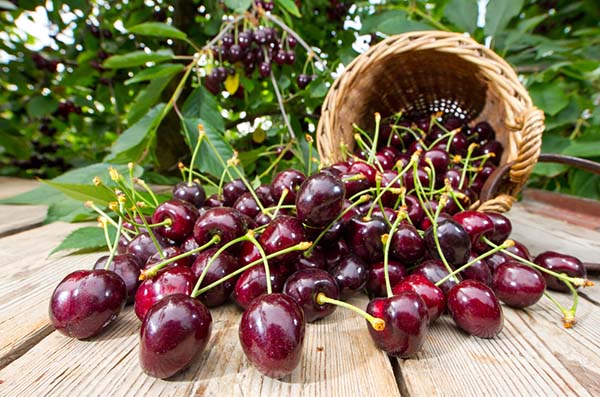
Content
The main activities for spring care for cherries
Removing a winter protective shelter from young seedlings
After the snow melts on the site and the soil freezes, in other words, a stable positive temperature is established, it will be possible to remove protective tapes or similar devices (tied branches of spruce branches) with which you prudently wrapped the lower part of the trunk of a young cherry seedling in order to protect it from rodents (mice and hares) and from sunburn (instead of whitewashing).
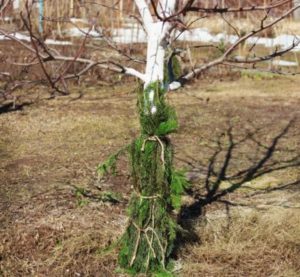
Important! Required wait for the soil to thaw! Premature removal of the tapes can cause the tender young bark to simply get sunburn (cracked) due to the early spring sun.
There is no reason to fear that the bark will rot under the straps as long as you have used the right = breathable (non-woven) material.
Treating trees after winter
If you didn’t start to make a protective shelter from rodents and they are serious damaged the bark at the bottom of the trunk your cherries, so to speak, gnawed with a ring, then in order to save the tree, you need to complete the "saving" vaccination bridge.
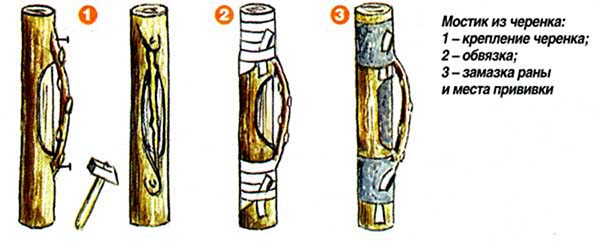
Note! Bridge inoculation is performed only when ring damage, in other cases, you need to do a little differently.
If the winter was severe, the trunks and branches froze, the bark began to peel off in some places (or cracked due to the lack of whitewash, in other words, the tree received sunburn), then all damaged areas must be carefully treated and treated:
- First you need to be careful remove dead bark to healthy tissue.
- Disinfect wound with 3% solution copper sulfate or 5% solution ferrous sulfate.
- Cover the bare trunk with garden pitch (alternatively, with a mixture of clay and mullein).
Whitewash
If you want whitewashing to have a practical value, and not aesthetic, then you need to whitewash the trees in autumn (in October-November) or in early spring (in March), but no way not in may.
We remind you! Trees are whitened to protect them from sunburn, which can lead to cracking of the bark.
As a rule, however autumn whitewashing is preferablesince in the first spring month, getting to the dacha is very, very problematic. Another thing is if you are the owner of a private house with a personal plot.
However, in the spring, a renewing (re) whitewashing is often done, for example, if it has washed off or peeled off badly over the winter.
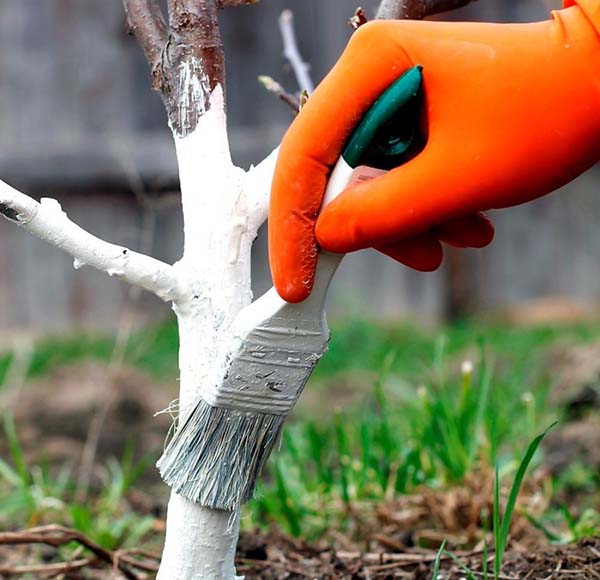
Advice! The site has detailed material about why, when and how to whiten trees.
Pruning
To ensure good growth and regular fruiting, cherries require annual pruning, which is recommended in early spring, before budding (in April).
The first step issanitary pruning (you need to remove all broken and dry branches damaged and frozen in winter) And already further:
- Continueform young seedlings (formative pruning).
- As for adult trees that have been bearing fruit for a long time, they will need such types of pruning as thinning, stimulating and rejuvenating (relevant for old and heavily overgrown trees).
By the way! More details about the spring procedure for pruning cherries - read in this article.
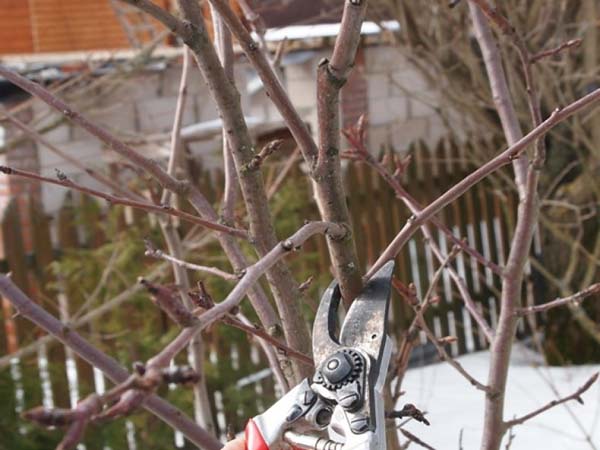
Watering, loosening and mulching
First of all, you should start by loosening the trunk circle in order to provide full access of air and nutrient moisture to the roots, because after the winter, the earth became quite compacted. In addition, loosening will get rid of some of the wintering pests and fungal spores.
Moreover, so that an earthen crust does not form, you can loosen it both before watering and after.
As for watering, in early spring (until May) trees, as a rule, have enough natural moisture after the snow melts.
However, cherries must be saturated with moisture well. before flowering and afterwhen the berries are poured. In this case, it is necessary to water abundantly so that the earth is soaked to a depth of 40 cm.
However, do not overdo it: excess moisture during the ripening period of the fruits will lead to their cracking.
Important! Trees need to be watered and fed around the crown circumference.
Video: how to water cherries in spring
In short, in May, before flowering, you need to loosen the near-stem circle, then water (according to the projection of the crown), and after absorbing moisture, mulch (if desired).
Why mulch plantings?
To prevent moisture evaporation and weed growth in the trunk circle. You can mulch with peat, humus, compost, cut grass, sawdust.
Important! The layer of mulch should not adhere tightly to the trunk (root collar), as this can lead to underpinning of the bark.
Top dressing
In spring, cherries should be fed in time so that the tree can quickly recover after winter and begin to develop actively.
Note! All the information you need to know how and what to fertilize cherries in spring and summer, you'll findin this article about feeding cherries.
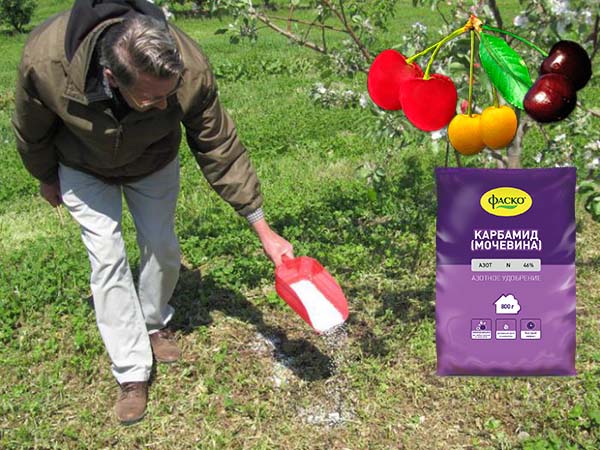
Many experienced gardeners use the following scheme for feeding cherries in spring and summer (the main dressings are highlighted in bold):
- in early spring (even in the snow) - you can perform a purely nitrogen fertilization (for example, ammonium nitrate) or complex, i.e. nitrogen-phosphorus-potassium (nitroammophos);
- before flowering - with complex fertilizers (more potassium);
- during flowering (if the weather is unfavorable) - foliar feeding with boron or any other means to improve fruit set;
- after flowering - nitrogen foliar feeding (urea);
- ovary formation - again potassium-phosphorus fertilizers (again, more potassium) + foliar dressing with microelements (magnesium, manganese, iron, calcium);
Advice! If you have already contributedphosphate fertilizers last year (autumn) thenin the spring, before and after flowering, can be usedonly potash, for example, potassium sulfate orwood ash.
- after fruiting and harvesting (autumn) - phosphorus-potassium root top dressing (superphosphate + potassium sulfate or potassium monophosphate).
Important! Sweet cherry is a stone fruit culture, which is why high-quality calcium nutrition (calcium is in calcium nitrate, wood ashas well as in dolomite flour).
And don't forget aboutmagnesium (for example, instead of potassium sulfate, potassium magnesium can be used).
Video: how to feed cherries
Treatment against diseases and pests
It is imperative to include preventive and therapeutic spraying of cherries from diseases and pests in the spring work calendar.
So, the most common fungal diseases affecting cherries are:
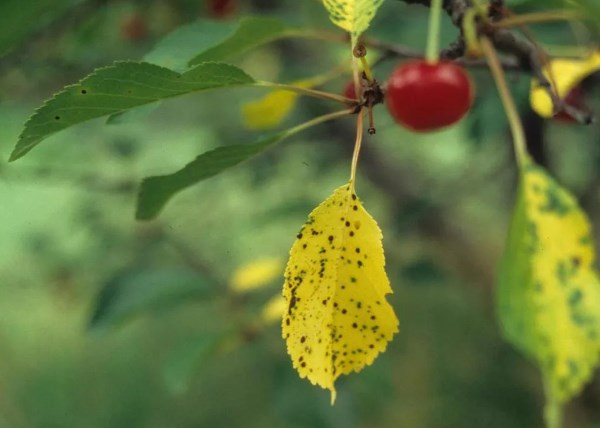
- perforated spotting (clasterosporium);
- moniliosis.
Of course, pests also attack cherries: cherry weevil, cherry fly, cherry moth, cherry slimy sawfly, aphids, spider mites and other insects.
To protect cherries from diseases and pests, in the spring it is necessary to carry out several timely preventive spraying:
- So, the first processing of cherries (which is most often called early spring eradication spraying) can still be drawn along bare branches (before the start of sap flow).
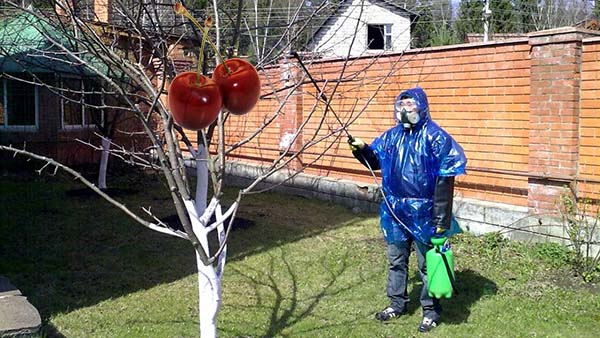
- Next, you need to do several mandatory spraying at certain stages of culture development ("green cone", "pink bud", "pea-sized ovary").
By the way! The site has a detailed article about how and what to process cherries from diseases and pests in spring.
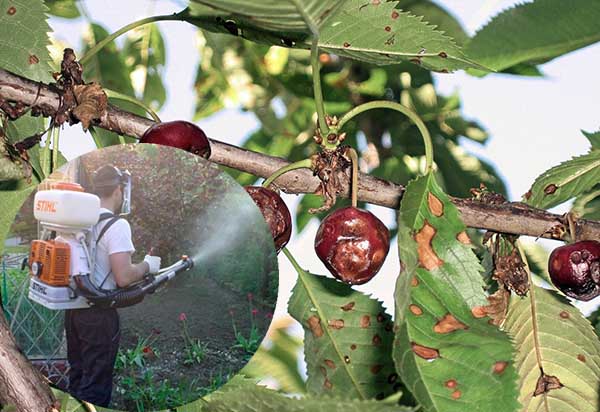
- And in the fall, before wintering, they also spend autumn eradication treatment.
Protection against returnable spring frosts
If frosts suddenly hit during flowering, they will damage the already opened flower buds and foliage.
You can save cherries from the negative effects of frost (more precisely, soften their effect) during flowering in one of the following ways:
- Sprinkling... In the evening, sprinkle abundantly with water and sprinkle (rain over) the crown.
The formation of a crust of ice on branches and flowers will prevent them from freezing.
Video: protecting trees from returnable spring frosts by sprinkling
- Another way to protect against frost is smoke... Namely, you need to light a fire (collect garbage and make a "smoke heap") when the air temperature drops to 0 degrees.
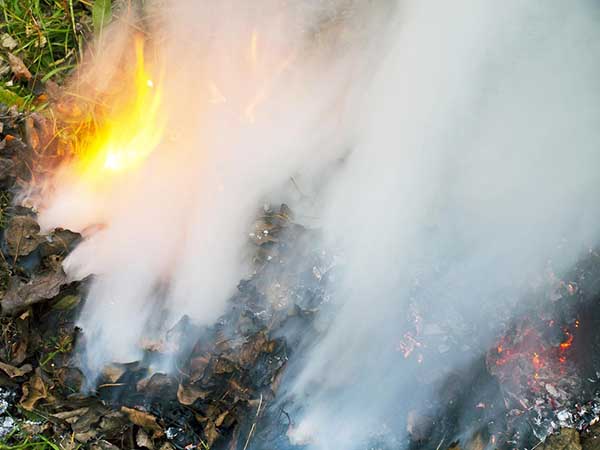
Saving the crop from birds
Birds (sparrows, starlings) and May beetles are very fond of sweet cherry fruits ... And if you do not want to share your harvest with them, then here is what you can do to protect it (scare away):
Advice! The site already has a separate detailed article about how to save ripening cherries from birds.
- Hang shiny on the branches computer disks;
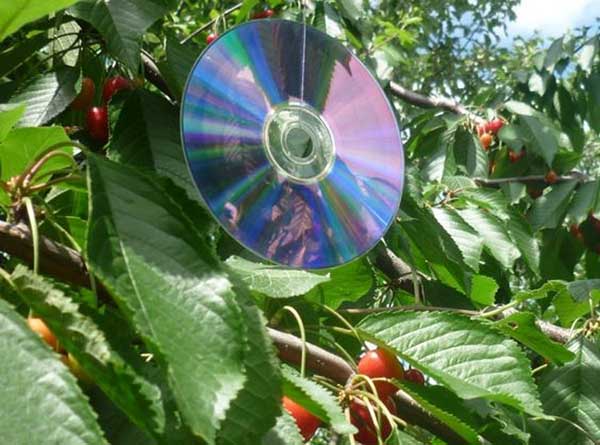
- Buy and shelter a tree special bird net.
Opinion! “They are not afraid of anything! Only the mesh helps. "
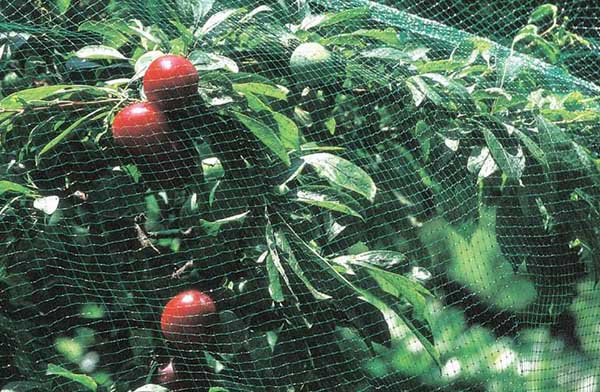
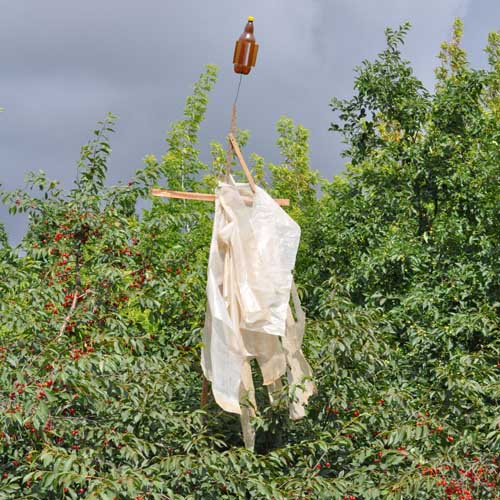
- Various ultrasonic repellents are also on sale. However, their effectiveness is very, very controversial.
By the way! More details, how to save the cherry crop from birds, you can learn from this material.
Other spring activities to do with cherries in the garden
Graft
Of course, in the spring you can start grafting cherries, and almost all methods are suitable for this (except budding - she is vaccinated in the summer): copulation, in the cleft, behind the bark, in the side cut or with a bridge.
By the way! As a rule, grafting cuttings (grafts) are cut during spring pruning.
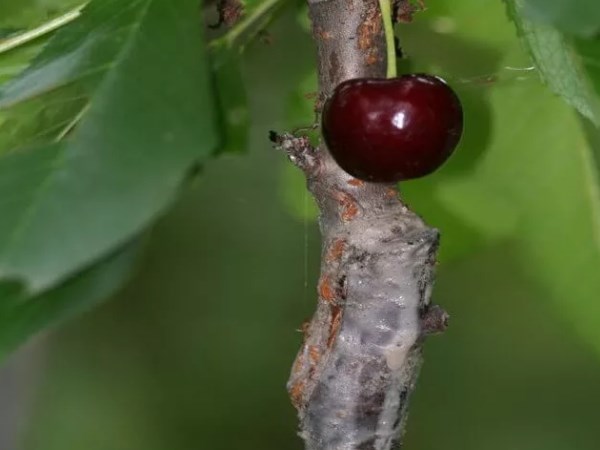
Planting new seedlings and replanting old ones to another place
If your cherry did not like the place chosen for it, or for some reason you need to transplant it to another part of the plot, then it's time to do it in early spring (before the start of sap flow, while the tree is still without leaves). If you can dig up a seedling without damaging the roots and at the same time preserving an earthen ball, then the tree will certainly quickly take root in a new place, practically not noticing changes.
As known, cherries, like cherries, are self-fertile crops, in other words, they require cross-pollination... Therefore, if you have only 1 tree in your garden, then you need to plant at least 1 more, or preferably 2 different varieties nearby (the same varieties are not suitable for pollination).
Advice! All the information you need about spring planting of cherry seedlings in open ground you'll find in this article.
Well, now you know what kind of care is required for cherries in the spring in order to always be with the harvest and feast on delicious berries every summer. Good luck!

